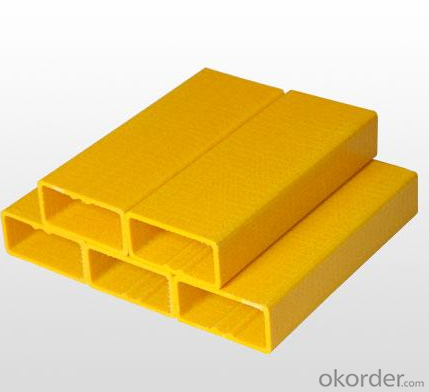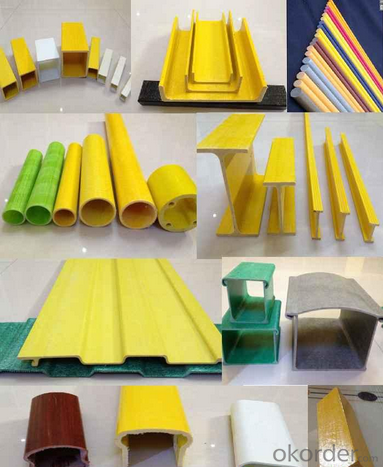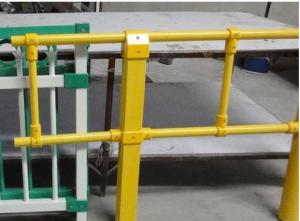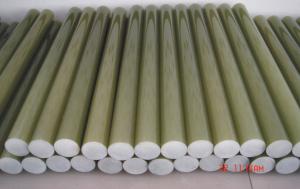FRP Pultrusion Profile High Strength Corrosion Resistant and Fire Resistant
- Loading Port:
- China Main Port
- Payment Terms:
- TT or LC
- Min Order Qty:
- 1000 m.t.
- Supply Capability:
- -
OKorder Service Pledge
OKorder Financial Service
You Might Also Like
Description of FRP PROFILE
FRP profiles have a lot of kinds, glass fiber reinforced plastic pipe, glass fiber reinforced plastic square tube, glass fiber reinforced plastic rectangular pipe, glass fiber reinforced plastic round bar, FRP flange beam.
The FRP profiles of the basic components for resin and glass fiber (including cloth, felt, etc.), it is a fiber (including glass fiber, carbon fiber, organic fiber and other metal, non-metallic fiber) as the reinforcing material to resin (mainly epoxy resin. Polyester resin, phenolic resin) for glue linker, auxiliary other auxiliary materials (main materials: release agent, curing agent, catalyst, sealing die agent, UV light stabilizer, clean die water, gel coat, etc.) composite and become. It has high temperature resistance, corrosion resistance, high strength, small specific gravity, low moisture absorption, extension small and insulation good and a series of excellent characteristics.

FRP Specification:
Round Rod: D2mm-20mm
Round Tube: OD3mm-38mm
Square Tube: OD12mm-100mm
Channel Rectangular Rod
T-shape and H-shape
C-shape
leg angles

Product features
1.Corrosion-resistant
2.Light weight, high strength
3.Longevity of service, non-maintaining
4.Steady whole performance
5.Anti-ageing
6.Well insulated

Application
The FRP channel products can resist corrosion from various gas or liquid such as acid,alkali,organic solvent and compound.They can be used as ladder material,and used in the electricity industries.
FAQ:
1.Are you the manufacture or trading Company?
we are the direct manufacturer
2.What are your payment terms ?
TT LC DP WESTERN UNION
- Q:What are the typical lifespan of FRP pultrusion profiles?
- The lifespan of FRP pultrusion profiles can vary depending on factors including material quality, environmental conditions, and specific application. On average, these profiles last 25 to 30 years. FRP pultrusion profiles are renowned for their durability and resistance to corrosion, rot, and UV radiation, which contributes to their extended lifespan. The use of top-notch resins and fibers during manufacturing ensures their ability to withstand harsh conditions and maintain structural integrity over time. It's worth mentioning that proper installation, regular maintenance, and adherence to usage guidelines can further increase the lifespan of FRP pultrusion profiles. Additionally, exposure to extreme temperatures, chemicals, and mechanical stress can impact their longevity. In summary, FRP pultrusion profiles provide a reliable and long-lasting solution for various applications in industries like construction, infrastructure, transportation, and marine.
- Q:Can FRP pultrusion profiles be used in wastewater treatment facilities?
- Yes, FRP (Fiber Reinforced Polymer) pultrusion profiles can be used in wastewater treatment facilities. FRP pultrusion profiles offer several advantages such as high strength-to-weight ratio, corrosion resistance, and durability, which make them suitable for use in harsh environments like wastewater treatment facilities. In wastewater treatment facilities, there are various applications where FRP pultrusion profiles can be used. These include but are not limited to walkways, handrails, ladders, grating, and structural supports. The corrosion resistance of FRP makes it ideal for use in areas exposed to moisture and chemicals present in wastewater. Furthermore, FRP profiles are lightweight, which simplifies installation and reduces the load on supporting structures. The durability of FRP pultrusion profiles ensures long-term performance, even in aggressive environments. They have a high resistance to chemical attack, UV radiation, and bacterial growth, making them suitable for wastewater treatment applications. Additionally, FRP profiles can be designed to meet specific load requirements and can be easily fabricated to fit various shapes and sizes. Moreover, FRP pultrusion profiles offer excellent electrical insulation properties, which can be advantageous in wastewater treatment facilities where electrical safety is a concern. In summary, FRP pultrusion profiles can be effectively used in wastewater treatment facilities due to their corrosion resistance, durability, lightweight nature, and versatility in design and fabrication. These profiles can provide long-lasting solutions for various applications within these facilities, ensuring operational efficiency and minimizing maintenance requirements.
- Q:Are FRP pultrusion profiles resistant to caustic solutions?
- Yes, FRP pultrusion profiles are generally highly resistant to caustic solutions. The inherent chemical resistance of fiberglass-reinforced plastic (FRP) combined with the corrosion-resistant properties of the pultrusion manufacturing process make FRP pultrusion profiles an excellent choice for applications involving caustic solutions.
- Q:Can FRP pultrusion profiles be used in the construction of agricultural structures?
- Yes, FRP (Fiber Reinforced Polymer) pultrusion profiles can be used in the construction of agricultural structures. FRP pultrusion profiles offer several advantages that make them suitable for agricultural applications. Firstly, FRP pultrusion profiles are lightweight yet strong, making them ideal for constructing agricultural structures such as greenhouses, barns, and storage facilities. Their high strength-to-weight ratio allows for easy installation and reduces the overall weight of the structure, thereby minimizing the need for heavy machinery during construction. Secondly, FRP pultrusion profiles are corrosion-resistant, which is a crucial characteristic for agricultural structures that are exposed to various environmental elements such as moisture, chemicals, and fertilizers. Unlike traditional materials like wood or steel, FRP does not rot, rust, or corrode, ensuring the longevity and durability of the agricultural structure. Additionally, FRP pultrusion profiles offer excellent electrical insulation properties. This is particularly beneficial in agricultural applications where electrical equipment, such as lighting systems or ventilation controls, are commonly used. The non-conductive nature of FRP prevents the risk of electrical shocks or short circuits. Moreover, FRP pultrusion profiles are highly customizable and can be designed to meet specific requirements. This flexibility allows for the creation of structures that are tailored to the unique needs of agricultural operations, such as load-bearing capacity, dimensional accuracy, and thermal insulation. Furthermore, FRP pultrusion profiles are non-magnetic, making them suitable for use in agricultural structures where magnetic interference can disrupt sensitive equipment or affect the growth of crops. Overall, the use of FRP pultrusion profiles in the construction of agricultural structures offers numerous benefits, including lightweight construction, corrosion resistance, electrical insulation, customization options, and non-magnetic properties. These advantages make FRP pultrusion profiles a viable and practical choice for agricultural applications.
- Q:Do you have any high temperature resistant resin made of pultruded glass fiber reinforced plastic?
- Process formula of high temperature epoxy resin pultrusion adhesive
- Q:How do FRP pultrusion profiles compare to traditional building materials?
- FRP pultrusion profiles offer numerous advantages over traditional building materials. They are lightweight yet incredibly strong, providing high structural integrity. These profiles are resistant to corrosion, chemicals, and UV radiation, ensuring long-term durability. Additionally, FRP pultrusion profiles have excellent insulation properties, making them ideal for various applications. They are also easy to install, require minimal maintenance, and are cost-effective in the long run. Overall, FRP pultrusion profiles outperform traditional building materials in terms of strength, durability, versatility, and efficiency.
- Q:What are the typical applications for FRP pultrusion profiles?
- FRP (Fiber Reinforced Plastic) pultrusion profiles find a wide range of applications across various industries. One of the most common uses is in the construction industry, where these profiles are used for structural components such as beams, columns, and platforms. They offer high strength-to-weight ratio, corrosion resistance, and durability, making them ideal for building infrastructure that requires long-lasting, low-maintenance solutions. In the transportation sector, FRP pultrusion profiles are used for manufacturing lightweight components like bus and truck bodies, railcar panels, and wind turbine blades. Their lightweight nature helps reduce fuel consumption and increase energy efficiency. Moreover, their resistance to chemicals, moisture, and UV radiation ensures their longevity even in harsh operating environments. In the electrical and power distribution field, FRP pultrusion profiles are utilized for manufacturing insulating supports, cable trays, and ladder racks. These profiles provide excellent electrical insulation properties, making them a safe and reliable choice for electrical installations. Additionally, their non-conductive nature helps prevent electrical accidents and eliminates the risk of electric shock. FRP pultrusion profiles also find applications in the marine industry, where their resistance to saltwater corrosion makes them suitable for manufacturing boat hulls, decks, and other marine components. Their high strength and stiffness make them capable of withstanding the harsh conditions of the marine environment. Furthermore, FRP pultrusion profiles are used in the chemical processing industry for manufacturing tanks, pipes, and platforms. Their resistance to various chemicals and corrosive substances ensures the integrity of the equipment and enhances safety in chemical plants. Overall, the typical applications for FRP pultrusion profiles span across industries such as construction, transportation, electrical, marine, and chemical processing. Their unique properties make them a versatile and reliable choice for various structural and functional applications.
- Q:Can FRP pultrusion profiles be used in the automotive industry?
- Certainly, the automotive industry can certainly make use of FRP (Fiber Reinforced Plastic) pultrusion profiles. These profiles possess several advantages that render them appropriate for automotive purposes. To begin with, FRP pultrusion profiles are lightweight, a critical factor in the automotive industry as it contributes to better fuel efficiency and reduced vehicle weight. Vehicles that are lighter consume less energy and emit fewer pollutants, making them more eco-friendly. Moreover, FRP pultrusion profiles exhibit a remarkable strength-to-weight ratio, enabling them to provide high strength and stiffness while remaining lightweight. This characteristic makes them ideal for structural components in automobiles, such as chassis, body panels, and support structures. In addition, FRP pultrusion profiles display exceptional corrosion resistance, a considerable advantage in automotive applications. Vehicles are frequently exposed to harsh environmental conditions, including moisture, salt, and chemicals. The corrosion resistance of FRP ensures the durability and longevity of automotive components, even in challenging environments. Furthermore, FRP pultrusion profiles possess impressive impact resistance, a crucial aspect of automotive safety. They can effectively absorb and dissipate energy during impacts, reducing the risk of injury in the event of accidents. Moreover, FRP pultrusion profiles can be customized and engineered to meet specific design requirements, allowing for versatility in automotive applications. They can be tailored to possess specific mechanical properties, shapes, and sizes, making them suitable for various automotive components. Overall, the combination of lightweight construction, high strength, corrosion resistance, impact resistance, and customization options make FRP pultrusion profiles an excellent choice for the automotive industry. They offer numerous benefits, including improved fuel efficiency, enhanced safety, and extended component life, making them a viable alternative to traditional materials in automotive applications.
- Q:Are FRP pultrusion profiles resistant to chemicals used in mining operations?
- Yes, FRP (Fiber Reinforced Polymer) pultrusion profiles are generally resistant to chemicals used in mining operations. FRP materials are known for their excellent chemical resistance properties, making them suitable for various corrosive environments, including mining operations. The resin matrix used in FRP pultrusion profiles can be selected to provide resistance against a wide range of chemicals commonly found in mining applications, such as acids, alkalis, solvents, and corrosive gases. Additionally, the reinforcement fibers, usually made of glass or carbon, further enhance the overall chemical resistance of the profile. Furthermore, FRP pultrusion profiles are non-conductive, which makes them an ideal choice for electrical and mining applications. They do not corrode or degrade under exposure to chemicals, ensuring durability and longevity in harsh mining environments. However, it is essential to consider the specific chemicals and concentrations used in mining operations. While FRP pultrusion profiles have excellent chemical resistance in general, prolonged exposure to extremely aggressive chemicals or high concentrations may require additional measures, such as selecting specific resin systems or surface coatings, to ensure optimal performance and longevity. It is advisable to consult with FRP manufacturers or experts to determine the best-suited materials for specific mining chemical environments.
- Q:Are FRP pultrusion profiles resistant to saltwater corrosion?
- Yes, FRP (Fiber Reinforced Plastic) pultrusion profiles are highly resistant to saltwater corrosion. The corrosion resistance of FRP profiles is one of their key advantages over traditional materials such as steel or aluminum. The combination of the reinforcing fibers and the resin matrix used in FRP pultrusion profiles makes them inherently resistant to the corrosive effects of saltwater. FRP profiles are composed of a mixture of glass or carbon fibers embedded in a thermosetting resin. These materials do not react with saltwater, preventing the corrosion that occurs in metals when exposed to saltwater for an extended period. Additionally, the resin matrix used in FRP profiles provides a protective barrier that further prevents saltwater from reaching the reinforcing fibers. The corrosion resistance of FRP pultrusion profiles makes them ideal for applications in marine environments. They are commonly used in structures such as seawalls, dock fenders, offshore platforms, and marine vessels. The durability of FRP profiles in saltwater environments ensures long-term performance and reduces the need for frequent maintenance or replacement. However, it is important to note that while FRP pultrusion profiles are highly resistant to saltwater corrosion, they may still be affected by other factors such as UV radiation or chemical exposure. Therefore, it is essential to consider the specific environmental conditions and consult with manufacturers or experts to select the most suitable FRP profile for a particular application.
1. Manufacturer Overview |
|
|---|---|
| Location | |
| Year Established | |
| Annual Output Value | |
| Main Markets | |
| Company Certifications | |
2. Manufacturer Certificates |
|
|---|---|
| a) Certification Name | |
| Range | |
| Reference | |
| Validity Period | |
3. Manufacturer Capability |
|
|---|---|
| a)Trade Capacity | |
| Nearest Port | |
| Export Percentage | |
| No.of Employees in Trade Department | |
| Language Spoken: | |
| b)Factory Information | |
| Factory Size: | |
| No. of Production Lines | |
| Contract Manufacturing | |
| Product Price Range | |
Send your message to us
FRP Pultrusion Profile High Strength Corrosion Resistant and Fire Resistant
- Loading Port:
- China Main Port
- Payment Terms:
- TT or LC
- Min Order Qty:
- 1000 m.t.
- Supply Capability:
- -
OKorder Service Pledge
OKorder Financial Service
Similar products
New products
Hot products
Related keywords






























